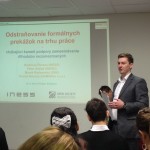Notes from an expert seminar
Panelists:
-
Radovan Ďurana (INESS) (presentation)
-
Peter Goliaš (INEKO) (presentation)
-
Marek Radvanský (Institute of Economics, Slovak Academy of Sciences) (presentation)
-
Tomáš Smutný (HUMANex, s.r.o.)
More than 20 representatives of NGOs, Roma employment organizations, journalists, politicians, embassies’ representatives and interested public attended the seminar organized by INESS on 15 December 2015.
Topic
The goal of the seminar was to describe the existing barriers on the labor market, which are the result of existing legislation and discuss possibilities of their removal, or change. The main sources of these barriers are the Labor code, administrative costs connected with the evidence and reporting, Health and Safety rules, and social contributions – especially on the special short term contracts.
The official state policy of marginalized groups (including Roma people) is focused mainly on the short term financial support of job placement creation, but ignores the problem of regulatory expenses, which are connected with employing and are the consequences of irresponsible attitude towards job market regulation.
Speakers’ Presentations
Radovan Ďurana (INESS analyst)
Radovan Ďurana welcomed the seminar participants and introduced a new study published by INESS: Unemployment – systemic problem of Slovak economy.
The goal of the study was to identify obstacles, which slow down new jobs creation and contribute to the persisting high unemployment rate in Slovakia. Concluding measures of the study were based on an empirical research amongst employers. The employment rate in Slovakia is experiencing growing trend and is coming close to the maximum of 2007-2008. Despite this fact, 400 thousand people remains unemployed and their average period of unemployment increases, reaching 14 months in 2012 and 17 months in 2014. Specific problem of unemployment in Slovakia is low education level of job seekers.
Regional differences in Slovakia are high and are reflected also in wage differential. Similarly, the minimum wage has different influence in Bratislava region (where it reaches 37.13% of median income) and different in Prešov region (54.32% of median income) in the year 2014. Minimum wage hikes since 2008 have overtaken the growth of median income in all regions, which pushed the bar for unemployed searching for a (legal) job higher. Compared to Czech Republic, Slovak employers have to pay 30 euro a month more for a minimum wage worker.
Low stress is put on removing the regulatory burden during the efforts to support job creation. Small entrepreneur has no chance to flow relevant legislation and the frequent changes, unless he employs a specialist. The regulatory burden was selected by 88% of the empirical survey respondents as more important job creation obstacle than minimum wage and social contributions expenses. Survey was conducted amongst 100 employers from all regions and is unique, since it was held among companies with revenues below 1 million euro and less than 20 employees. This group of employers is important for employing of the long-term unemployed, but is missing in the official statistics.
24% of employers stated, that they would create additional job placement, if the minimum wage was 300 euro. This proves the premise that the minimum wage is an obstacle in job creation in many sectors.
Part of the survey was devoted to employing of Roma. Half of the respondents had an experience with employing Roma, and 71% believes, that their induction training is more difficult compared to the majority representatives. 59% of employers think, that employees prefer companies, which do not employ Roma. Half of the employers with Roma employees believes, that their work quality bears no difference with the work of other employees.
Survey amongst 32 municipalities (27 of them had an experience with employing Roma) showed that also in their case social contribution costs (labor cost) influences their motivation to create jobs. Lowering the social contributions would be considered by 69% of them as an opportunity to employ another person. In case of municipalities, the survey showed that work done by Roma is considered having equal quality compared to majority too.
Based on the analysis of labor market obstacles and results of the empirical survey, authors propose to shift the current deductible from the health insurance contributions formula to the social contributions formula. This would enable employment cost to lower and partially rise the net income of employees.
The 200 euro deductible should be introduced also into the social contributions formula of all special short term contracts, as it is the in case of student contracts. Minimum wage should be regionalized. The state should systematically deregulate the conditions of employing and change the Labor Code in order not to be an obstacle for job creation and willingness to offer employees with indefinite contract.
The study Unemployment – systemic problem of Slovak economy was prepared with a grant assistance of the Open Society Foundations and follows up an earlier study named Roma and Social Benefits.
Peter Goliaš (Director of INEKO)
Peter Goliaš introduced results of a survey conducted among economic analysts, which was focused on identification of precautions considered as effective in battling the unemployment. Analysts rated not only effectiveness, but also political acceptability of these precautions. The demand to measure effectiveness of policies and according to their regular evaluation to re-adjust the policies was rated at the first place. Reduction of administrative and regulatory burden including more flexible Labor Code scored second. Connection of schools with job market and success rates of their graduates on the market are important as well. Analysts also favor evaluation of public job centers, or improvement of World Bank’s Doing Business ranking of Slovakia, which measures the international competitiveness of a country.
Concurrence of social benefits and wage should be introduced to all unemployed, not only the long term unemployed subgroup. They consider the construction of public for-rent apartments in less developed regions (current policy in place) ineffective, as well as intensive support of employing youth, or creation of continuously subsidized jobs.
Peter Goliaš further pointed the low net income of self-employed persons with revenues at the level of minimum wage, with an earnings differential of 57 euro compared to a standard employee. This setting of social contributions formula demotivates people from starting their own businesses as self-employed, which is one of the solutions in locations with missing infrastructure and industrial background. INEKO proposes further cuts in social contributions for low-income earners. They suggest to broaden the deductible also for self-employed, so it would be counted towards revenues, not the tax calculation base. They propose also introducing the deductible for all groups of special short term contract employees with low income.
Marek Radvanský (head of the Economic modeling and analysis department at the Institute of Economics, Slovak Academy of Sciences)
Marek Radvanský presented outcomes of several studies focusing on the labor market, conducted by Institute of Economics of Slovak Academy of Science (SAS). He pointed at the coming drop of workforce size due to demographic development. He presented the existing age structure of employees in various sectors, which indicated the need to replace the outgoing employees. For example, 37 % employees in the education sector is older than 50 years. According to SAS prognosis the job market will need the same numbers of basic education employees and university graduate employees by 2025.
His next point was the evaluation of the effects of Active Labor Market Measures (AOTP) using the contrafactual method. This method tries to identify the effect of the Measures by comparing individuals with the same characteristics, who did not participate in some of the Measures.
Graduate training benefit recipient had 7 percentage points higher chance to find a job after 3 months when compared to non-recipient (the difference shrunk to 2 pp after 15 months). One of the study outcomes is the knowledge that success of a policy measure heavily depends on their use in the real world. Partly because of this reasons, authors suggest that job centers should be evaluated and rewarded according to their performance. Job centers should have the authority to prepare their own portfolio of measures according to their regional specifics.
According to another study, average public expenditure on one unemployed was 9,000 euro in 2012. That is a benchmark value, which can be used to evaluate cost effectiveness of creation of a subsidized job. Economists from SAS evaluated the influence of structural and cohesion EU funds on job creation. According to their analysis, the funds helped to create 110 thousand jobs, out of which 40 thousand can be considered long-term.
Marek Radvanský concluded, that the economy will not generate enough jobs for low-skilled workers, the stability and improvement of the business environment is the key for job generation and AOTP evaluation is an important condition for effective use of EU funds. Regional convergence did not happen despite the use of EU funds, however, the disparity would be even higher without the structural and cohesion funds,
Tomáš Smutný (HUMANex, s.r.o.)
Tomáš Smutný introduced his company, which employs large share of low skilled employees and work in facility care, hospitality and moving sectors. The company employs almost 300 people, including Roma, but also Egyptians for example. Mr. Smutný pointed at the existence of numerous regulatory obstacles in the way of job creation. E.g. low flexibility and low work quality of the job centers in organizing a mass job interviews. He quoted the study conducted by the experts of Profesia.sk job portal, which identified 84 administrative actions required for 1 employee hired for 12 months. Another of his complaints was focused on the irrationality of the 140 euro limit of income and maximum weekly work time for unemployed. During his speech, he introduced other examples, how state institutions uselessly rise administrative costs for employers instead of improving conditions of employees. Government agencies check (and penalize) trivial details, e.g. existence of paper version of the electronic attendance forms. Government agencies often control also rules impossible to comply with. For example, they ask employers to check, if their employees have not claimed deductible also with some other employer (which is prohibited), but there are no databases where this information could be found. If the employer lies and claims deductible with more employers, the employers have to retrospectively pay back social contributions both for their and their employee’s part!
He concluded his speech with belief, that the market has a huge demand also for low-skilled workforce, but it is necessary to remove the obstacles created by state regulations.
Q&A
Speakers answered questions and insights from the audience during discussion. They discussed the impacts of the educational system orientation on the income distribution. Speakers argued with opinion from the audience, if the minimum wage is sufficient for covering the basic needs. Lucia Kureková (Slovak Governance Institute) pointed at the fact, that higher costs of Roma job training are influenced by their longer periods of unemployment, compared to the majority, they have less developed work habits and lower qualification. Klára Orgovánová (Roma Institute) asked about the experience with Social Company (special form of subsidized companies employing long-term unemployed). Robert Chovanculiak (INESS) expects higher influence of school ranking on the demand from students, Peter Goliaš consequently illustrated the influence of rankings on school’s behavior. Marek Radvanský answered the question of Jaroslava Lukačovičová (Šanca political party), how the regionalization of minimum wage should be conducted in reality and if regionalization of social benefits should follow.







